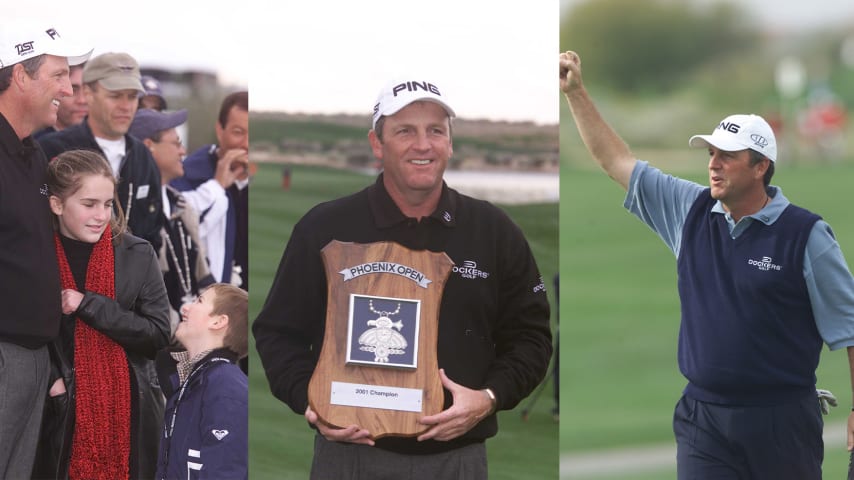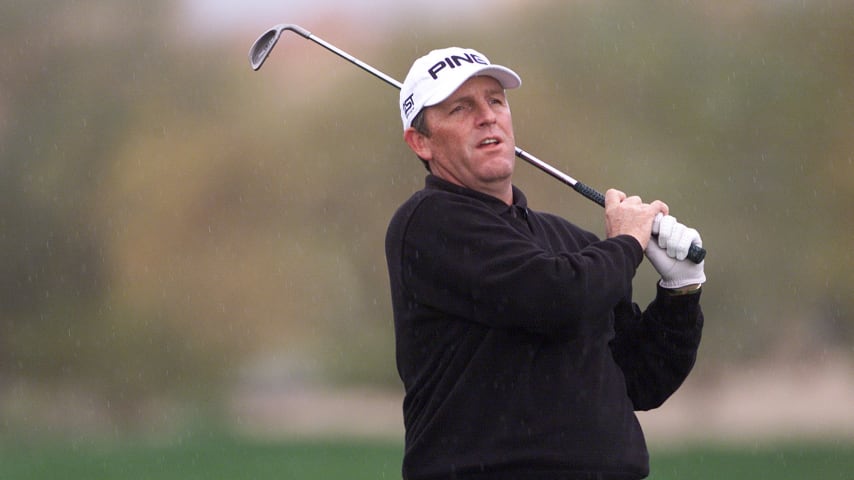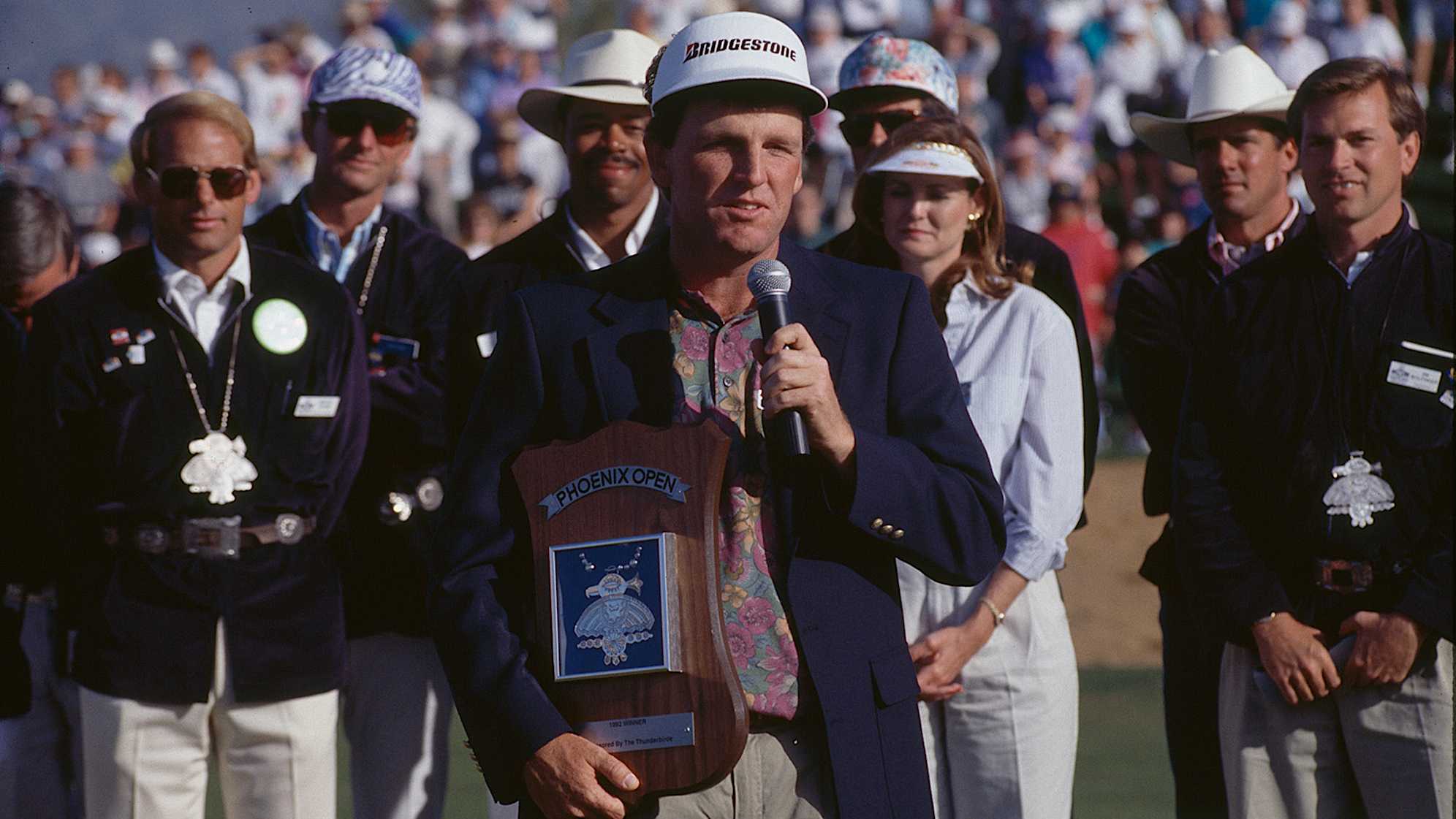‘I knew I was the favorite’: Mark Calcavecchia reflects on third win at TPC Scottsdale
8 Min Read

Mark Calcavecchia after winning the 2001 Phoenix Open. (Jonathan Ferrey/ALLSPORT)
Written by Mark Calcavecchia
Editor’s Note: In 27 career WM Phoenix Open starts, Mark Calcavecchia won three titles and finished in the top 10 six other times, but it wasn’t as if he did a lot of practicing and playing at TPC Scottsdale. Calcavecchia, a former resident of Ahwataukee, a Phoenix suburb, spent most of his time working on his game at nearby Desert Mountain Club. It only seemed like Calcavecchia had mastered TPC Scottsdale. Seventy-two of his 92 career rounds at the Tom Weiskopf-designed course were par or better, but none was better than his second-round 60 in the 2001 tournament, and none of his other WM Phoenix Open starts compared to his triumph two days later. Calcavecchia was simply dominant during his four rounds at the 2001 event, a tournament he has watched grow and grow and, well, grow into what it is today. The 13-time PGA TOUR winner, who has picked up an additional four PGA TOUR Champions titles, reflects on his week in the desert 23 years ago when everything about his game came together at once.
I tried to Monday qualify into Phoenix my rookie year of 1982 when the tournament was still held at Phoenix Country Club, but I was unsuccessful, and I didn’t play in my first tournament until 1987. After that, you could say I had a little success at TPC Scottsdale, and during each of my visits, I had a front-row seat as I watched the growth of what is now known as the WM Phoenix Open.
At my first official tournament appearance, I kept a pretty good streak going to begin my 1987 season. I tied for third in the Tournament of Champions (now The Sentry), was third at the Bob Hope (Chrysler Classic, now The American Express) and then tied for third in Scottsdale. What I remember about the tournament itself on my first visit to TPC Scottsdale was it felt very much like any other PGA TOUR event. There was a TGI Fridays tent behind the 16th tee, and that was pretty much it other than a few concessions stands here and there. There were really no grandstands or bleachers. The fans just watched from the hills around the course, the way all TPCs were designed.

Mark Calcavecchia during the 2001 Phoenix Open. (Jonathan Ferrey/ALLSPORT)
Two years later, I won the tournament – and I could sense the event was growing, again, though, it wasn’t anything dramatic. I won for a second time, in 1992, and that’s when I noticed the tournament infrastructure as far as tents and grandstands was much bigger, especially around the 16th and 17th greens. The crowds were larger, and it was getting a little more rowdy.
By the time 2001 came, the year of my third and last Phoenix title, while the course was still essentially the same, the look of the tournament was completely different, and there was a unique feel to the place with the way it marketed itself and how big everything had become. Even then, however, it’s nothing like what I see on TV today each February.
I am one of four players to win the Phoenix Open three times, putting me in pretty nice company with Arnold Palmer, Gene Littler and Phil Mickelson. What sets me apart from those World Golf Hall of Famers is my combined margin of victory in my three wins. I won in 1989 by seven strokes over Chip Beck, I beat Duffy Waldorf by five in 1992, and I was an eight-shot winner over Rocco Mediate in my last victory. What’s also unique is that while my three titles are separated by only 12 years, I have the distinction of winning in three different decades, my last victory quite memorable.

Mark Calcavecchia is congratulated by his caddie Drake Oddy after winning the 2001 Phoenix Open. (Craig Jones/ALLSPORT)
On Tuesday of that week in 2001, I was hitting balls on the range when I discovered something. All of a sudden, I started striping it. My buddy Drake Oddy was caddying for me, and I turned to him and said, “Let’s go play 11 through 15 and see how it goes.”
On those five holes, I almost holed-out a couple of iron approach shots. Yep, it was working. Then on Wednesday in the pro-am it was more of the same. I was either 6- or 7-under through 11 holes, and I said to Drake, “I’m going to make a couple of intentional bogeys because I don’t want to shoot 62 on Wednesday. I'm just going to slough off here and miss a few putts on purpose. So don’t worry.”
Because of what I figured out on the range, I knew I was the favorite to win. Now nobody else knew that. But I knew. If I just kept doing what I had been doing, come Sunday I figured I would be in the mix. Naturally, when you feel like that, it doesn’t always mean you’re going to win because one day you’ll think, “Oh, I got it,” and go out and play a great round. Then the next day you’ll do the same thing you were doing before the good round, and you can’t hit it for crap.
Fortunately for me, the latter scenario never materialized. In the first round, I took right off and had it going on every iron shot I hit. Even a “bad” shot, when I would mishit it, I would look up, and the ball was 15 feet from the hole instead of 5 feet. On other days, a mishit would leave me 40 feet from the cup – or off the green entirely.
I opened the tournament with a 65 and trailed a trio of guys by a stroke. In the second round, I set the TPC Scottsdale course record, with an 11-under 60, thanks to 11 birdies and seven pars. At the halfway mark, I led Scott Verplank by five. In the third round, I backed up the 60 with a 64, a bogey on the par-3 16th ending my streak of 45 consecutive par-or-better holes. With 18 holes to play, I was 24-under and led Mediate by six and Verplank, Chris DiMarco and Steve Lowery by 11.
Even though I could feel myself pulling away each day, I never really thought about playing conservatively because of the way I was hitting the ball. I just kept my foot on the gas. When I got out there Sunday afternoon, I saw nothing but the pins with the thought that I would continue to make more birdies.
That’s a feeling – being in the zone or whatever you want to call it – that rarely comes along in this game.
All day Sunday, I did a good job of not letting my brain get in the way. I didn’t talk myself out of stuff by playing safe or not going for a pin. I kept thinking birdie. I knew at No. 11, I had to be aware of pulling my drive in the water, and at 12 I had to guard against pushing my drive into the lake. On those holes – that resulted in two pars – I strictly focused on hitting good shots into those greens.
Once I got to No. 13, and I had a seven-shot lead, I knew I couldn’t screw up the last six holes bad enough to lose. I also had been around enough to know I couldn’t start thinking about my trophy-acceptance speech and stop concentrating, either. Plus, I still had 16 to play.
Now the par-3 16th was the same hole in 2001 that it is today. The surroundings are what’s different. But even back then, 23 years ago, the build-out for fan seating was impressive, and a huge crowd had gathered for the final groups coming in.
With seemingly everybody watching me, all I did was hit a beautiful 7-iron to about 10 feet, and from there, I made the birdie putt. The noise was incredible.
I didn’t know it at the time, but I needed to birdie one of the last two holes to set the TOUR’s 72-hole scoring record. On the par-4 17th, I made birdie and now all I needed was to finish with a par. With the tournament outcome long since decided, I put my ball on the green in two, missed my birdie putt and faced a 2-footer for par for a 67 and the TOUR record.
Again, I had no idea a par would put my name in the record book, so I wasn't thinking about that. I just wanted to finish in style. Now I ask: How can you get nervous on a 2-1/2-foot putt when you have an eight-shot lead? I don’t know, but I was. Standing over the ball, I somehow made the putt; it hit the lip and fell in.
I can’t say it was the best stroke I’ve ever made on the green, and, yes, it would have been a total bummer had I missed that putt. But I didn’t and this was my result: 28-under, a 256 total and the record. Though I didn’t have an eagle that week, I did make 32 birdies, and 20 of my birdie putts were inside three feet.
I may have had more consequential wins in my career, but in terms of total control of my game, that week at TPC Scottsdale that resulted in my 11th TOUR win – and the third on the property – was easily my best.



